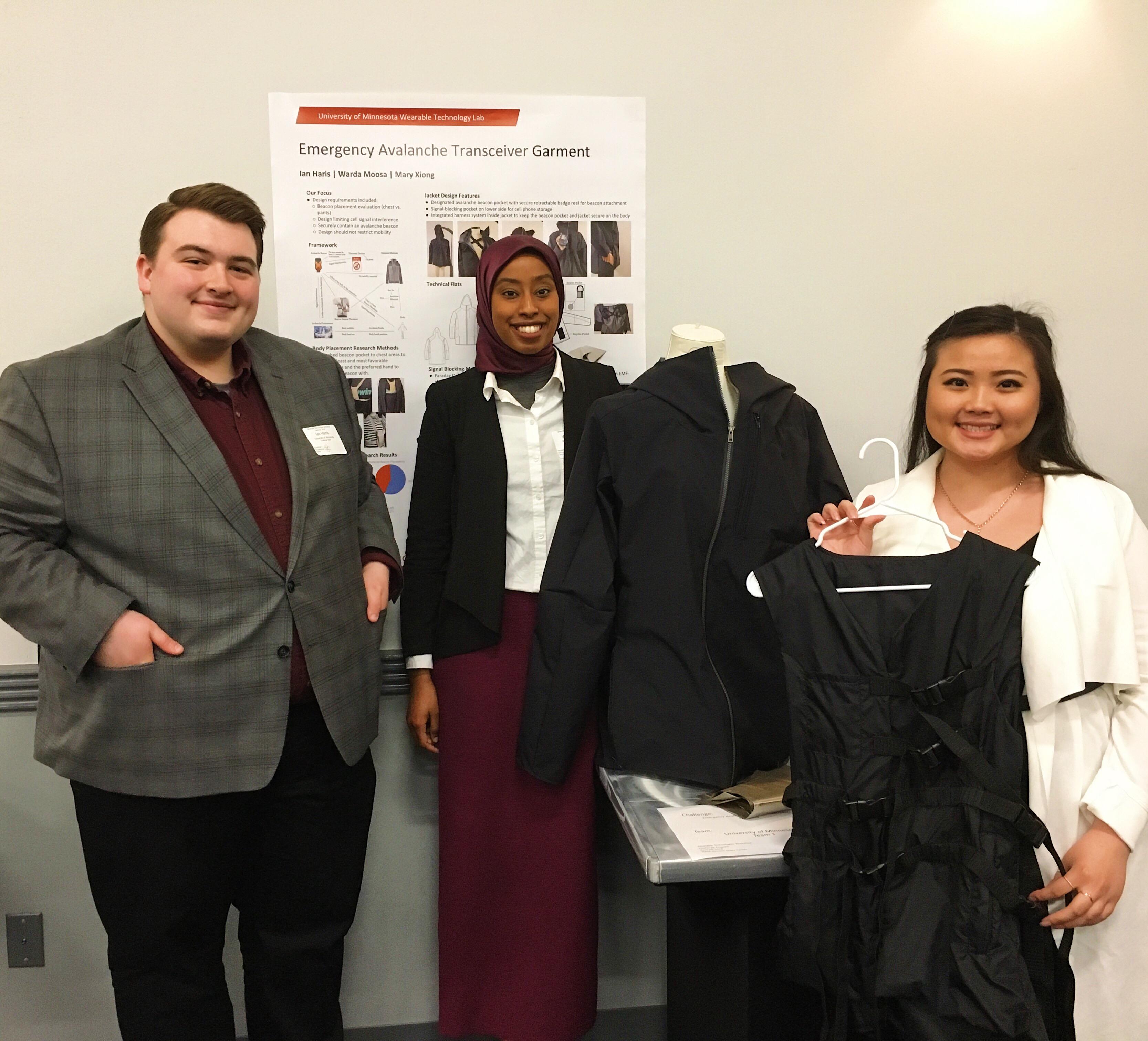What started as a class project for Ian Harris, Warda Moosa, and Mary Xiong (all Apparel Design) turned into the prize-winning entry at the Industrial Fabrics Association International (IFAI) Advanced Textiles Student Design Competition. Together the three seniors (then juniors) created an emergency avalanche transceiver garment that took first place in this national competition.

Every spring, apparel design juniors in Studio IV select from a series of project design briefs for the annual NASA spring research symposium. While most of the project briefs are provided by NASA, some outside companies are also allowed to submit briefs. Last year one of the outside companies was Patagonia, whose proposal caught the attention of Harris, Moosa, and Xiong. “I was personally more interested in working on a project for Patagonia because I knew it would make better use of my apparel skills,” explained Harris. “While I had no experience working with wearable technology, I felt more comfortable working with this brief because, in the end, Patagonia wanted a garment.”
Patagonia’s proposal was to create an emergency avalanche transceiver garment that could combat interference and boost an emergency beacon’s signal for backcountry winter sport use. “I do not really partake in outdoor winter sports. I’m pretty sure the only thing I have done remotely close to backcountry skiing is going tubing at Buck Hill,” said Harris. “But, as a Minnesotan, I do have a good understanding of winter so that made me interested in what type of fabrics and materials we would use in our eventual prototype.”
To meet the specifications of Patagonia’s design brief, the students focused on four research initiatives: strategically placing the beacon, limiting interference to the beacon signal, securing the beacon, and maintaining user mobility. One of the most important challenges the team faced concerned limiting interference to the beacon’s signal. In her research, Moosa sourced Faraday Defense material, an EMF shielding fabric with copper and nickel coated fibers. This fabric blocks out signals that may interfere with the beacon’s broadcasting.
To test potential interference, the group placed a phone running an app that came with the Faraday fabric in-between varying layers of the material and recorded the results.”I tested the fabric in three rounds. The first round had one layer of the Faraday fabric, the second round had two layers of the fabric, and the third round had three,” explained Moosa. “I wanted to test the different layers to see if there was a relationship between the number of layers and the amount of cell signal blocked by the fabric.”
The testing revealed that the Faraday fabric could block signals and interference with the beacon. The more layers of fabric, the more interference was blocked. “I don’t think I would have ever sought out that type of fabric to help limit the interference with the beacon signal. Utilizing it was what helped us stand out when we submitted the project to IFAI,” said Harris.
“We also tested how placing the beacon on the body could interfere with the mobility of the wearer,” said Xiong. “Through a variety of tests, we concluded that the best placement would be on the upper left area of the chest.”
The final prototype, a jacket shell, reflects all of this work. With a designated avalanche beacon pocket on the upper left area of the front chest, the inside of the prototype features an integrated harness system to keep the beacon pocket and jacket secure on the wearer’s body. A user would simply put the jacket on, click the harness into place, zip up the front, and then be good to go.
“As a team, I think we were unsure of whether or not to submit our prototype but after reading through the requirements, we thought it fit the bill and it would be a cool opportunity,” explained Harris. “We didn’t think much of it for the rest of the summer until we all received an email in mid-August notifying us of our win! I was totally surprised and honored that they chose our project.” This past October, the three-member team went down to Orlando, FL, to present their project on the show floor at the annual IFAI Expo. While at the Expo, they were able to meet with professionals in the industrial fabrics industry and sit in on lectures regarding advancements in textiles.
The prototype will now be sent to Patagonia and the company will decide if it wants to implement any of the group’s prototype design decisions into its work.
The global fashion industry is one of the most resource-intensive in the world. On Wednesday, April 25, apparel design students will re-imagine the industry and shine a light on its environmental impact at the Weisman Art Museum’s (WAM) (RE)generation showcase.
A breakthrough invention in wearable technology has the potential to change how we interact with the clothes we wear every day.
Pushing the boundaries of traditional fashion, this year’s senior apparel design fashion show, Amplified, speaks to a variety of lifestyles and cultures. From modest formalwear to colorful street style and theatrical costume play this year’s show explores fashion’s influences on social responsibility, gender fluidity, virtual reality, modern cultural expressions, and much more.





